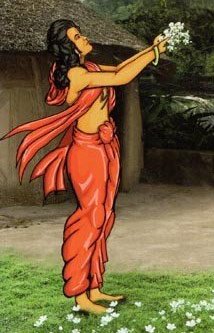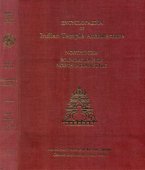Candravati, Candravatī, Candrāvatī: 12 definitions
Introduction:
Candravati means something in Buddhism, Pali, Hinduism, Sanskrit, the history of ancient India. If you want to know the exact meaning, history, etymology or English translation of this term then check out the descriptions on this page. Add your comment or reference to a book if you want to contribute to this summary article.
Alternative spellings of this word include Chandravati.
In Hinduism
Purana and Itihasa (epic history)
Source: Wisdom Library: Varāha-purāṇa1) Candravatī (चन्द्रवती) is the name of a river mentioned in a list of rivers, flowing from the five great mountains (Śailavarṇa, Mālākhya, Korajaska, Triparṇa and Nīla), according to the Varāhapurāṇa chapter 82. Those who drink the waters of these rivers live for ten thousand years and become devotees of Rudra and Umā.
2) Candrāvatī (चन्द्रावती).—Name of a river (nadī) situated near the seven great mountains on the western side of mount Naiṣadha, according to the Varāhapurāṇa chapter 83. These settlements consume the water flowing from these seven great mountains (Viśākha, Kambala, Jayanta, Kṛṣṇa, Harita, Aśoka and Vardhamāna). Niṣadha (Naiṣadha) is one of the seven mountains located in Jambūdvīpa, ruled over by Āgnīdhra, a grandson of Svāyambhuva Manu, who was created by Brahmā, who was in turn created by Nārāyaṇa, the unknowable all-pervasive primordial being.
One of the five mountains situated near Bhadrāśva, according to the Varāhapurāṇa chapter 82. The Varāhapurāṇa is categorised as a Mahāpurāṇa, a type of Sanskrit literature preserving ancient India’s vast cultural history, instructions for religious ceremonies and a whole range of topics concerning the various arts and sciences. The original text is said to have been composed of 24,000 metrical verses, possibly originating from before the 10th century.
Source: archive.org: Puranic Encyclopedia1) Candrāvatī (चन्द्रावती).—Daughter of Sunābha, the asura. Pradyumna, son born to Śrī Kṛṣṇa of Rukmiṇī, married Prabhāvatī, daughter of the asura called Vajranābha. Sunābha was the younger brother of Vajranābha. Sunābha had two daughters called Candrāvatī and Guṇavatī. These girls once saw Pradyumna and Prabhāvatī engaged in love-talk and they were attracted by Pradyumna. They requested Prabhāvatī to select husbands for them also from among the Yādavas. Prabhāvatī, in her childhood had learnt from Durvāsas a mantra, the repetition of which by a woman thinking in mind of any male would help to secure that male as the husband for her. Prabhāvatī taught that mantra to Candrāvatī and Guṇavatī. They thought respectively of Gada and Sāmba and repeated the mantra with the result that Gada married Candrāvatī and Sāmba married Guṇavatī.
2) Candrāvatī (चन्द्रावती).—A wife of Hariścandra in his former birth. (See Hariścandra).
Source: Cologne Digital Sanskrit Dictionaries: The Purana Index1) Candravatī (चन्द्रवती).—A river born of Mārīṣā.*
- * Matsya-purāṇa 4. 50.
2) Candrāvatī (चन्द्रावती).—A river of the Ketumāla.*
- * Vāyu-purāṇa 44. 19.

The Purana (पुराण, purāṇas) refers to Sanskrit literature preserving ancient India’s vast cultural history, including historical legends, religious ceremonies, various arts and sciences. The eighteen mahapuranas total over 400,000 shlokas (metrical couplets) and date to at least several centuries BCE.
Shilpashastra (iconography)
Source: archive.org: Illustrations of Indian Music and Dance in Western Indian StyleCandrāvatī (चन्द्रावती) refers to a type of mūrchanā (melodic mode), and its illustration as a Goddess (according to 15th-century Indian art) is as follows.—The colour of her body is golden. She holds baṅsi with both hands. She wears a bodice of light-green colour and a scarf with crimson-coloured design. She wears a trouser of light-green colour bearing a white design.
The illustrations (of, for example Candrāvatī) are found scattered throughout ancient Jain manuscripts from Gujarat. The descriptions of these illustrations of this citrāvalī are based on the ślokas of Vācanācārya Gaṇi Sudhākalaśa’s Saṅgītopaniṣatsāroddhāra (14th century) and Śārṅgadeva’s Saṅgītaratnākara (13th century).

Shilpashastra (शिल्पशास्त्र, śilpaśāstra) represents the ancient Indian science (shastra) of creative arts (shilpa) such as sculpture, iconography and painting. Closely related to Vastushastra (architecture), they often share the same literature.
Kavya (poetry)
Source: Wisdom Library: Kathāsaritsāgara1) Candravatī (चन्द्रवती) is one of the two wifes of Padmasena: one of the two sons of the Vidyādhara king Muktasenā, according to the Kathāsaritsāgara, chapter 42. Accordingly, as Indīvarasena said to king Parityāgasena after remembering his former live: “... then a maiden, named Ādityaprabhā, the daughter of a chief of the Vidyādharas, of her own accord, out of love, chose Padmasena for her husband. Hearing of that, a Vidyādhara maiden, of the name of Candravatī, became love-sick also, and came and chose him for her husband”.
2) Candravatī (चन्द्रवती) is the daughter of the Brāhman Candrasvāmin and his wife Devamati from Devakamalapura according to the Kathāsaritsāgara, chapter 56. Accordingly, “... and in the meanwhile his wife Devamati brought forth to Candrasvāmin another child, beautiful in all her limbs. And the brother and sister, Mahīpāla and Candravatī, grew up together in their father’s house”.
3) Candravatī (चन्द्रवती) is the wife of king Dharma from Dakṣiṇāpatha (the Deccan), according to the twenty-fourth story of the Vetālapañcaviṃśati in the Kathāsaritsāgara, chapter 98. Accordingly, “... he [king Dharma] had a wife named Candravatī, who came from the land of Mālava; she was of high lineage, and the most virtuous of women. And that king had born to him by that wife one daughter, who was not without cause named Lāvaṇyavatī”.
4) Candravatī (चन्द्रवती) is the daughter of king Candraśekhara from Suvarṇadvīpa, as mentioned in the Kathāsaritsāgara, chapter 123. Accordingly, “... and the next day that king [Candraśekhara] put on board a ship in a lucky moment his daughter Candravatī, whom he had long intended to give to King Vikramāditya, with that Guṇavati, and sent her off with much magnificence as a gift to that sovereign”.
The Kathāsaritsāgara (‘ocean of streams of story’), mentioning Candravatī, is a famous Sanskrit epic story revolving around prince Naravāhanadatta and his quest to become the emperor of the vidyādharas (celestial beings). The work is said to have been an adaptation of Guṇāḍhya’s Bṛhatkathā consisting of 100,000 verses, which in turn is part of a larger work containing 700,000 verses.

Kavya (काव्य, kavya) refers to Sanskrit poetry, a popular ancient Indian tradition of literature. There have been many Sanskrit poets over the ages, hailing from ancient India and beyond. This topic includes mahakavya, or ‘epic poetry’ and natya, or ‘dramatic poetry’.
In Buddhism
Tibetan Buddhism (Vajrayana or tantric Buddhism)
Source: Wisdom Library: Tibetan BuddhismCandrāvatī (चन्द्रावती) is the name of Vidyārājñī (i.e., “wisdom queen”) mentioned as attending the teachings in the 6th century Mañjuśrīmūlakalpa: one of the largest Kriyā Tantras devoted to Mañjuśrī (the Bodhisattva of wisdom) representing an encyclopedia of knowledge primarily concerned with ritualistic elements in Buddhism. The teachings in this text originate from Mañjuśrī and were taught to and by Buddha Śākyamuni in the presence of a large audience (including Candrāvatī).

Tibetan Buddhism includes schools such as Nyingma, Kadampa, Kagyu and Gelug. Their primary canon of literature is divided in two broad categories: The Kangyur, which consists of Buddha’s words, and the Tengyur, which includes commentaries from various sources. Esotericism and tantra techniques (vajrayāna) are collected indepently.
Mahayana (major branch of Buddhism)
Source: archive.org: Bulletin of the French School of the Far East (volume 5)Candravatī (चन्द्रवती) [?] (in Chinese: Tchan-ta-lo-po-ti) is the name of an ancient kingdom associated with Puṣya or Puṣyanakṣatra, as mentioned in chapter 18 of the Candragarbha: the 55th section of the Mahāsaṃnipāta-sūtra, a large compilation of Sūtras (texts) in Mahāyāna Buddhism partly available in Sanskrit, Tibetan and Chinese.—Chapter 18 deals with geographical astrology and, in conversation with Brahmarāja and others, Buddha explains how he entrusts the Nakṣatras [e.g., Puṣya] with a group of kingdoms [e.g., Candravatī] for the sake of protection and prosperity.

Mahayana (महायान, mahāyāna) is a major branch of Buddhism focusing on the path of a Bodhisattva (spiritual aspirants/ enlightened beings). Extant literature is vast and primarely composed in the Sanskrit language. There are many sūtras of which some of the earliest are the various Prajñāpāramitā sūtras.
India history and geography
Source: archive.org: Nilamata Purana: a cultural and literary study (history)Candravati (चन्द्रवति) is the name of a river mentioned in the Nīlamatapurāṇa .—Candravati (the mother of the Daityas) is stated to have assumed the form of this river. In the verses 289, 485, 1297-98, 1299-1300 and 1389 this river is mentioned along with the Trikoṭi and the Harṣapathā. The Harṣapathā is identified by Stein with the Ārapath—the stream which joins the Vitastā near Anantanag. Candravatī and Trikoṭi may have been the designations of some rivulets meeting the Vitastā not very far from its confluence with the Harṣapathā.
The Candravatī also represents the personification of the Goddess Diti.
Source: OpenEdition books: Vividhatīrthakalpaḥ (History)Candrāvatī (चन्द्रावती) is the name of village twenty-three km. north-east of Vārāṇasī, as is mentioned in the Vividhatīrthakalpa by Jinaprabhasūri (13th century A.D.): an ancient text devoted to various Jaina holy places (tīrthas).

The history of India traces the identification of countries, villages, towns and other regions of India, as well as mythology, zoology, royal dynasties, rulers, tribes, local festivities and traditions and regional languages. Ancient India enjoyed religious freedom and encourages the path of Dharma, a concept common to Buddhism, Hinduism, and Jainism.
Languages of India and abroad
Sanskrit dictionary
Source: Cologne Digital Sanskrit Dictionaries: Monier-Williams Sanskrit-English Dictionary1) Candravatī (चन्द्रवती):—[=candra-vatī] [from candra-vat > candra > cand] f. (tī) Name of a daughter of Su-nābha and wife of Gada, [Harivaṃśa 8762 and 8779]
2) [v.s. ...] of a princess, [Bhaviṣya-purāṇa, khaṇḍa 1 & 2: bhaviṣya-purāṇa & bhaviṣyottara-purāṇa; Pañcatantra ii, 4, 1/2]
3) [v.s. ...] of the wife of a potter, [Rājataraṅgiṇī i, 323]
4) [v.s. ...] of several other women, [Kathāsaritsāgara]
5) [v.s. ...] of a town, [Śukasaptati] (cf. drā-v).
6) Candrāvatī (चन्द्रावती):—[=candrā-vatī] [from candra > cand] f. Name of a place of pilgrimage
7) [v.s. ...] of the wife of king Dharma-sena, [Vetāla-pañcaviṃśatikā xxv.]
[Sanskrit to German]
Sanskrit, also spelled संस्कृतम् (saṃskṛtam), is an ancient language of India commonly seen as the grandmother of the Indo-European language family (even English!). Closely allied with Prakrit and Pali, Sanskrit is more exhaustive in both grammar and terms and has the most extensive collection of literature in the world, greatly surpassing its sister-languages Greek and Latin.
See also (Relevant definitions)
Partial matches: Candra, Vati.
Starts with: Candravatimurchana.
Ends with: Paripurnasahasracandravati.
Full-text (+1): Candravant, Trikoti, Paripurnasahasracandravati, Paramara, Murchana, Harshapatha, Anumati, Vimala, Sunabha, Lavanyavati, Candravatimurchana, Jalapura, Sravanti, Vishnuvarman, Anantasvāmin, Marisha, Pushya, Adityaprabha, Padmasena, Mura.
Relevant text
Search found 9 books and stories containing Candravati, Candra-vati, Candra-vatī, Candrā-vatī, Candravatī, Candrāvatī; (plurals include: Candravatis, vatis, vatīs, Candravatīs, Candrāvatīs). You can also click to the full overview containing English textual excerpts. Below are direct links for the most relevant articles:
Garga Samhita (English) (by Danavir Goswami)
Verse 5.1.23 < [Chapter 1 - Advice to Kaṃsa]
Chaitanya Bhagavata (by Bhumipati Dāsa)
Verse 3.3.205 < [Chapter 3 - Mahāprabhu’s Deliverance of Sarvabhauma, Exhibition of His Six-armed Form, and Journey to Bengal]
Verse 1.13.59-60 < [Chapter 13 - Defeating Digvijayī]
Puranic encyclopaedia (by Vettam Mani)
Kathasaritsagara (the Ocean of Story) (by Somadeva)
Chapter XCVIII < [Book XII - Śaśāṅkavatī]
Vetāla 3: The King and the Two Wise Birds < [Appendix 6.1 - The Twenty-five Tales of a Vetāla]
Chapter LVI < [Book IX - Alaṅkāravatī]
Trishashti Shalaka Purusha Caritra (by Helen M. Johnson)
Part 14: Journey to Acalapura < [Chapter III - Vasudeva’s Marriage with Kanakavatī and her Former Incarnations]
Part 2: First incarnation as Dhana < [Chapter I - Previous incarnations of Ariṣṭanemi (Nemi)]
Part 16: Resumption of Nala story < [Chapter III - Vasudeva’s Marriage with Kanakavatī and her Former Incarnations]
Harivamsha Purana (by Manmatha Nath Dutt)
Chapter 95 - Pradyumna Appears Before Prabhavati and Marries Her < [Book 2 - Vishnu Parva]
Chapter 97 - Vajranabha Wants to Conquer the Celestial Region < [Book 2 - Vishnu Parva]
Related products
